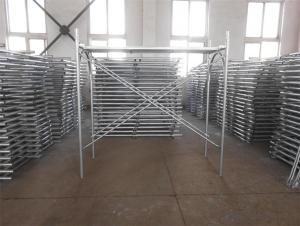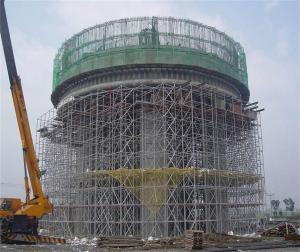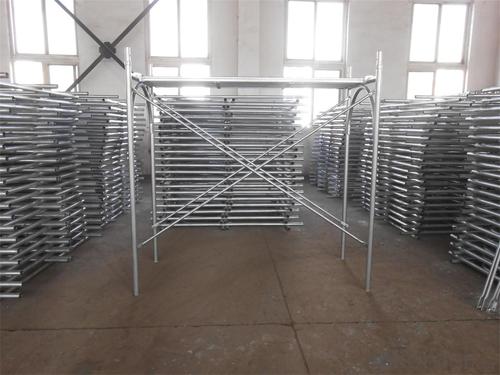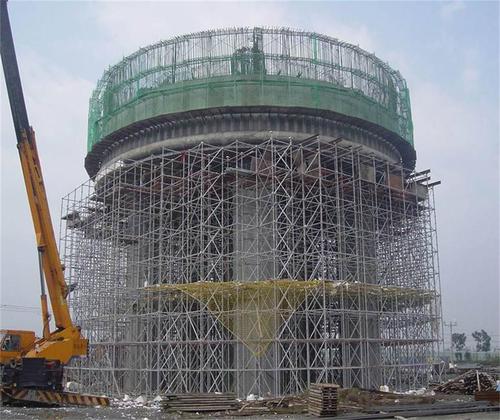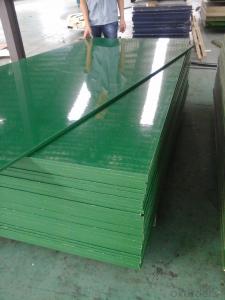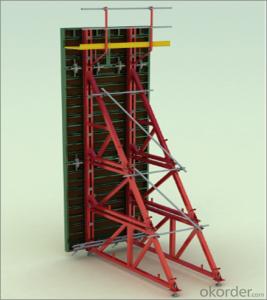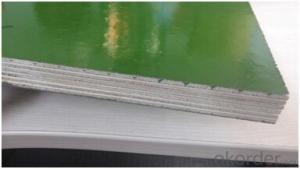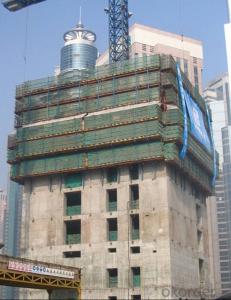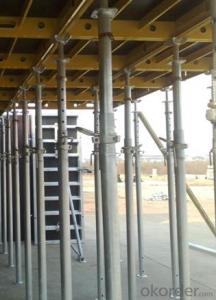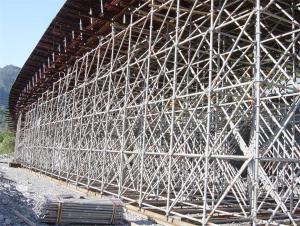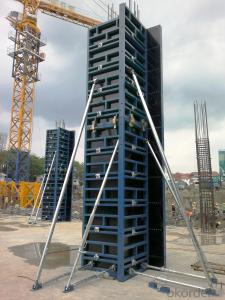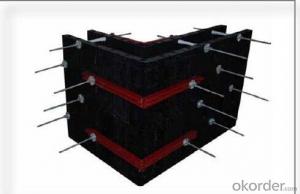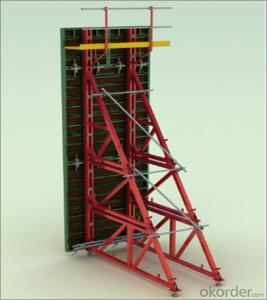Ring lock or Tower Scaffolding with Hot or Cold Galvanized Surface
- Loading Port:
- Shanghai
- Payment Terms:
- TT OR LC
- Min Order Qty:
- 1000 m²
- Supply Capability:
- 100000 m²/month
OKorder Service Pledge
OKorder Financial Service
You Might Also Like
1.Structure of Ring lock Description
Ringlock Scaffolding system is the most popular used Scaffolding system in the world.It will greatly reduce the cost because of the following advantages
Packaging & Delivery
Packaging Details:
Pallet or bag or upon client's request
Delivery Detail:
35days
2.Main Features of Ringlock
It will greatly reduce the cost because of the following advantages
1)Using less pipes
2)Easy to install
3)It can be used again and again for nearly 20years
3.Ring lock product pictures:
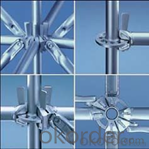
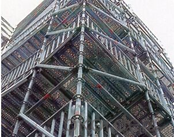
4.Ringlock Product Description
Type: ringlock scaffolding diagonal Brace
specification : Ø48.3×3.20
material:: steel Q235
Finished: Hot DIP galvanized, painted
Diagonal length(m) :Weight(kg)
0.9m * 1.25m 6.28
1.25m * 2.7m 11.45
5.FAQ
We have organized several common questions for our clients,may help you sincerely:
1)How about your company?
CNBM International Corporation, China National Building Materials (Group) Corporation, is one of the largest companies in China building material equipment industry, Our formwork and scaffolding are largely used in both domestic and all over world;
2)How many Scaffolding your company have?
Here comes our 5 types of Scaffolding systems:
- Cup lock Scaffolding(C-Lock Scaffolding)
- Ring lock Scaffolding
-Kwistage Scaffolding
-H-frame Scaffolding
-ID15 Scaffolding Tower, this type Scaffolding is the most widely used in construction, such like bridge.
3)How long can we receive the product after purchase?
Lead time is about 30days after getting the signed PI and deposit.
- Q: What are the different types of formwork release agents used with steel frame formwork?
- There are several types of formwork release agents that can be used with steel frame formwork. These release agents help to prevent the concrete from sticking to the formwork, allowing for easy removal once the concrete has cured. 1. Petroleum-based release agents: These are the most commonly used formwork release agents. They are made from a mixture of petroleum oils and other additives. Petroleum-based release agents provide good release properties and are easy to apply. They can be used on both steel and wooden formwork. 2. Water-based release agents: These release agents are made from a mixture of water and additives such as surfactants. They are environmentally friendly and have low VOC (volatile organic compound) content. Water-based release agents are suitable for use with steel formwork and can provide a good release surface. 3. Silicone-based release agents: Silicone-based release agents are often used when a higher level of release is required. They provide a superior surface finish and can be used with steel formwork. However, silicone-based release agents can be more expensive than petroleum or water-based options. 4. Non-staining release agents: Non-staining release agents are used when a clean and stain-free concrete surface is desired. These release agents do not leave any residue on the concrete surface, ensuring a high-quality finish. They are commonly used in architectural applications where the appearance of the concrete is important. 5. Form release papers: Form release papers are an alternative to liquid release agents. They are thin, flexible sheets that are placed between the formwork and the concrete. Form release papers provide an effective release surface and can be used with steel formwork. They are easy to use and eliminate the need for applying a liquid release agent. It is important to choose the appropriate formwork release agent based on the specific requirements of the project. Factors such as the desired finish, environmental concerns, and cost should be taken into consideration when selecting the type of release agent to use with steel frame formwork.
- Q: What are the advantages of using steel frame formwork?
- There are several advantages of using steel frame formwork in construction projects. Firstly, steel frame formwork provides high strength and durability, allowing it to withstand the pressure and weight of concrete. This ensures a stable and secure structure. Secondly, steel frame formwork is highly versatile and can be easily customized to fit various shapes and sizes, making it suitable for a wide range of construction projects. Additionally, steel frame formwork offers excellent reusability, reducing the overall cost and waste associated with formwork systems. Lastly, steel frame formwork provides efficient and quick assembly and dismantling, saving time and labor during the construction process.
- Q: Can steel frame formwork be used for both straight and curved slabs?
- Yes, steel frame formwork can be used for both straight and curved slabs. The steel frames can be easily adjusted to create the desired shape and can withstand the pressure of concrete, making it a versatile option for various slab designs.
- Q: How does steel frame formwork help in reducing on-site material storage?
- Steel frame formwork helps in reducing on-site material storage by providing a reusable and efficient system for creating concrete structures. Unlike traditional timber formwork, steel frame formwork is more durable and can be used multiple times, eliminating the need for excessive material storage on-site. Additionally, the compact and lightweight nature of steel frame formwork allows for easy transportation and assembly, further reducing the need for large storage spaces.
- Q: What are the key quality control measures for steel frame formwork installation?
- There are several key quality control measures that should be followed for steel frame formwork installation. These measures are crucial to ensure the structural integrity and safety of the formwork system. 1. Proper inspection: Before starting the installation process, it is important to thoroughly inspect the steel frame formwork. This includes checking for any damages, defects, or missing components. Any issues should be addressed and resolved before proceeding with the installation. 2. Accurate alignment: The steel frame formwork should be properly aligned to ensure that it fits together seamlessly and provides a stable structure. This includes checking the vertical and horizontal alignment of the components, as well as ensuring that they are level and plumb. 3. Secure connections: The connections between the steel frame formwork components should be secure and tight. This can be achieved by using appropriate fasteners, such as bolts or screws, and ensuring that they are properly tightened. Loose connections can lead to instability and compromise the integrity of the formwork system. 4. Level and flat surfaces: The surfaces of the steel frame formwork should be level and flat to provide a stable and uniform support for the concrete. This can be achieved by using leveling tools, such as spirit levels or laser levels, to ensure that the formwork is properly aligned and adjusted. 5. Reinforcement placement: If reinforcement bars are required in the formwork system, they should be properly placed and secured. This includes ensuring that the bars are correctly positioned and adequately supported to prevent displacement during the concrete pouring process. 6. Adequate bracing: Steel frame formwork should be adequately braced to provide stability and prevent any deformation or collapse. This can be achieved by using diagonal braces or stiffeners, as well as ensuring that all bracing components are properly secured and tightened. 7. Regular inspection and maintenance: Throughout the installation process, regular inspections should be conducted to identify any potential issues or defects. Any damages or defects should be repaired or replaced immediately to ensure the safety and effectiveness of the formwork system. By following these key quality control measures, the steel frame formwork installation can be carried out efficiently and effectively, resulting in a robust and reliable structure for concrete casting.
- Q: How does steel frame formwork compare to other formwork systems in terms of cost?
- Steel frame formwork is generally more expensive compared to other formwork systems in terms of upfront cost. However, it offers long-term cost savings due to its durability and reusability. Steel frame formwork can be used for multiple projects, reducing the need for frequent replacements. Additionally, its strength and stability result in faster construction times, reducing labor costs.
- Q: Can steel frame formwork be used for both concrete walls and slabs?
- Steel frame formwork is a versatile and durable system that can be used for both concrete walls and slabs. It provides support and containment for the concrete during construction. The system consists of steel panels or frames that are assembled and locked together to create the desired shape and size for the concrete structure. It can be easily adjusted and reconfigured to accommodate different types of concrete elements. Additionally, steel frame formwork has a high load-bearing capacity, allowing it to withstand the pressure exerted by wet concrete. It is rigid and stable, ensuring precise alignment and smooth finishes for the concrete walls and slabs. In summary, steel frame formwork is a reliable and efficient solution for constructing concrete walls and slabs.
- Q: How does steel frame formwork handle different types of concrete mixes?
- Steel frame formwork is highly versatile and capable of handling different types of concrete mixes effectively. Its robust and sturdy construction ensures it can withstand the pressure and weight of various concrete compositions, including high-strength mixes. The steel framework provides excellent support and stability during the pouring and curing process, ensuring the concrete retains its desired shape and strength. Furthermore, steel frame formwork offers flexibility in adjusting the formwork to accommodate different concrete mixes, allowing for precise construction and customization.
- Q: Can steel frame formwork be used for both interior and exterior slab construction?
- Yes, steel frame formwork can be used for both interior and exterior slab construction. Its sturdy and durable structure allows it to withstand the pressures and forces exerted during concrete pouring and curing, making it suitable for various construction applications, regardless of whether they are indoors or outdoors.
- Q: Can steel frame formwork be used for precast concrete cladding?
- Yes, steel frame formwork can be used for precast concrete cladding. Steel frame formwork is commonly used in the construction industry for its durability and strength. It provides a sturdy structure for pouring and shaping concrete, making it suitable for creating precast concrete cladding panels. The steel frame formwork ensures the desired shape and dimensions of the cladding are achieved, resulting in a high-quality finish.
Send your message to us
Ring lock or Tower Scaffolding with Hot or Cold Galvanized Surface
- Loading Port:
- Shanghai
- Payment Terms:
- TT OR LC
- Min Order Qty:
- 1000 m²
- Supply Capability:
- 100000 m²/month
OKorder Service Pledge
OKorder Financial Service
Similar products
Hot products
Hot Searches

